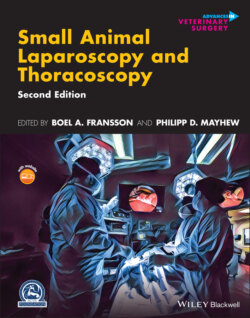Читать книгу Small Animal Laparoscopy and Thoracoscopy - Группа авторов - Страница 128
Monopolar Electrosurgery
ОглавлениеThe monopolar system is the most commonly used electrosurgical device. It consists of a generator, an electrosurgical pencil (active electrode), and a return electrode, which is the grounding pad (passive electrode). The generator directs a current through the electrosurgical pencil, which contains the active electrode. The current then passes to the tissue through the patient's body to the grounding pad and back to the generator (Figure 5.3). The tissue effect is determined by the power setting, waveform, technique (contact, noncontact, and time), and electrode configuration. The passive electrode should maintain a wide contact area to minimize the chance of concentrating the current and patient burning. Previous rigid metal plates were associated with increased burns because of rigidity, which often led to decreased contact with the plate to the patient. Newer electrosurgery generators also come with return electrode monitoring (REM), in which a generator will cease operation if the return signal is outside programmed limits.
Monopolar electrosurgery provides hemostasis for vessels smaller than 2 mm in diameter, and collateral damage can occur up to 2 cm from the coagulation site [6, 7].
A multitude of electrodes are available for the electrosurgical pencil, with three basic shapes: Needle tip, spatula, and J‐hooks. The use of insulated electrode extensions has become popular for endoscopic surgery. These extensions enable the use of the standard electrosurgical pencil in endoscopic surgery (Figure 5.4). An L‐ or J‐hook electrode is also very commonly used during minimally invasive surgery (MIS) for dissection. These electrodes allow dissection of tissue by hooking in the tip while the ESU is activated. This technique is used frequently during cholecystectomy. With the advent of the TriVerse handpiece (Valley Lab, Boulder, CO), the surgeon can adjust the power level with the handpiece rather than relying on an assistant to adjust the power at the generator (Figure 5.5). Monopolar electrodes are available in a device that also allows for irrigation and suction at the surgical site. With the irrigation and suction present, the surgical field can be kept clean, and more precise and efficient dissection can be performed with the monopolar cautery tip. An insulated endoscopic instrument can be connected to an ESU and used as a monopolar electrosurgery device. Endoscopic grasping forceps may then be used to provide hemostasis. Insulated endoscopic scissors can also be used. A foot pedal is used to activate the electrocautery unit when the scissors are cutting tissue. Hand‐activated switches are also available.
Figure 5.3 Alternating current flows from the generator to the handpiece. Electrical current then flows from the electrode (handpiece) to the patient and then to the return electrode.
Source: From Taheri et al. [5].
Figure 5.4 Electrode extensions are available in various tip configurations.
Source: From Huhn [3].
Figure 5.5 Both J‐ and L‐shaped extensions are available for use with monopolar electrosurgery. Their extended lengths make them ideal for use in minimally invasive surgery. Also pictured is Valley Lab's TriVerse handpiece, which has a sliding switch to allow for adjustment of power delivery at the handpiece in addition to the generator.
Source: From Huhn [3].
